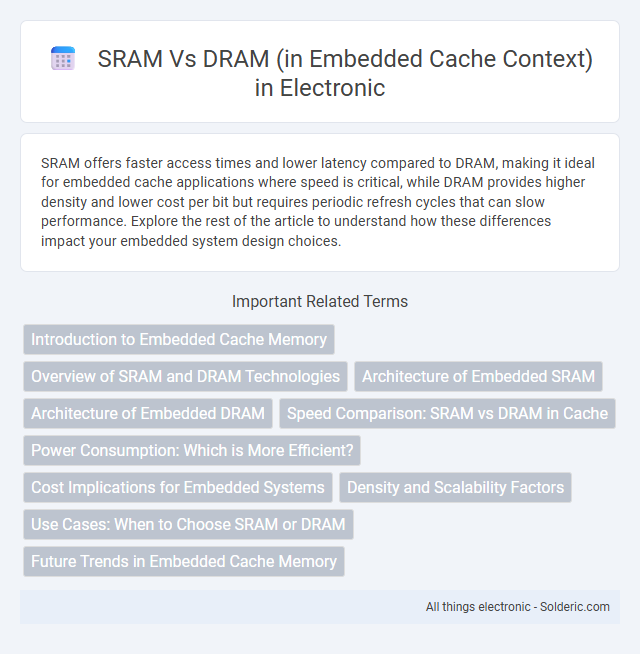SRAM offers faster access times and lower latency compared to DRAM, making it ideal for embedded cache applications where speed is critical, while DRAM provides higher density and lower cost per bit but requires periodic refresh cycles that can slow performance. Explore the rest of the article to understand how these differences impact your embedded system design choices.
Comparison Table
| Feature | SRAM | DRAM |
|---|---|---|
| Type | Static RAM (6-transistor cell) | Dynamic RAM (capacitor-based) |
| Usage in Embedded Cache | Primary choice; fast access, low latency | Rarely used; slower, requires refresh |
| Speed | Fast (Access time: ~1-2 ns) | Slower (Access time: ~10-100 ns) |
| Volatility | Volatile but data retained as long as power is on | Volatile; requires periodic refresh to maintain data |
| Power Consumption | Lower dynamic power; no refresh needed | Higher due to refresh cycles |
| Density | Lower density (larger cell size) | Higher density (smaller cell size) |
| Complexity | Simple control circuitry | Complex controller needed for refresh management |
| Cost | Higher per bit | Lower per bit |
| Leakage | Higher leakage current in idle | Lower leakage but refresh overhead |
Introduction to Embedded Cache Memory
Embedded cache memory primarily uses SRAM due to its faster access times and lower latency compared to DRAM, making it ideal for high-speed data retrieval in processors. SRAM's static nature allows it to retain data without refresh cycles, which reduces power consumption and enhances performance in embedded systems. Your embedded cache benefits from SRAM's reliability and rapid access, enabling efficient handling of critical data close to the CPU.
Overview of SRAM and DRAM Technologies
SRAM uses bistable flip-flop circuits, offering fast access times and low latency, making it ideal for embedded cache memory in processors. DRAM stores data as charge in capacitors, providing higher density and lower cost per bit but with slower access due to periodic refresh requirements. Your embedded system benefits from SRAM's speed and reliability in cache, while DRAM suits larger, cost-sensitive main memory applications.
Architecture of Embedded SRAM
Embedded SRAM in cache memory features a static flip-flop-based architecture that holds data as long as power is supplied, enabling faster access times compared to DRAM. Its design includes cross-coupled inverters forming bistable latches, allowing immediate data retrieval without the need for refresh cycles, which is critical for high-speed embedded systems. You benefit from lower latency and increased reliability in embedded caches due to SRAM's inherent architectural advantages over DRAM.
Architecture of Embedded DRAM
Embedded DRAM (eDRAM) features a capacitor-based architecture that allows higher density storage than SRAM by using one transistor and one capacitor per bit, enabling more memory in a smaller area. The capacitor stores charge representing data, but requires periodic refreshing, which adds complexity compared to SRAM's flip-flop design. eDRAM's architecture balances density and speed, making it suitable for embedded cache where larger cache sizes are needed with moderate access latency.
Speed Comparison: SRAM vs DRAM in Cache
SRAM offers significantly faster access times than DRAM, making it ideal for embedded cache applications where speed is critical. The absence of refresh cycles in SRAM enables lower latency and quicker data retrieval compared to DRAM's periodic refresh requirements. Your system's performance improves with SRAM-based caches due to its ability to provide rapid and consistent access speeds essential for real-time processing.
Power Consumption: Which is More Efficient?
SRAM in embedded cache consumes less power during operation due to its static nature, retaining data without constant refreshing, unlike DRAM which requires periodic power-intensive refresh cycles. This reduced power consumption makes SRAM highly efficient for low-power embedded systems where energy conservation is critical. Your embedded cache benefits from SRAM's efficiency, extending battery life and reducing thermal output in portable devices.
Cost Implications for Embedded Systems
SRAM offers faster access speeds and lower latency compared to DRAM, making it ideal for embedded cache applications, but it comes with significantly higher production costs due to its complexity and larger transistor count per bit. DRAM, while slower and requiring periodic refresh cycles, provides a more cost-effective solution for higher-capacity memory needs in embedded systems. Your choice between SRAM and DRAM impacts both the overall system cost and performance balance, especially in cost-sensitive embedded designs.
Density and Scalability Factors
SRAM offers lower density compared to DRAM due to its complex six-transistor cell design, limiting scalability in embedded cache applications. DRAM achieves higher density through a simpler one-transistor-one-capacitor cell, enabling greater scalability for large cache sizes. However, SRAM's faster access times and lower latency make it preferable for smaller, high-speed embedded caches despite its limited density.
Use Cases: When to Choose SRAM or DRAM
SRAM is ideal for embedded cache due to its fast access times and low latency, making it suitable for instruction and data caches in CPUs where speed is critical. DRAM, with higher density and lower cost per bit, is preferred for larger memory storage requirements but is less suitable for cache due to slower access speeds and complexity in refresh cycles. Your choice depends on whether you prioritize speed and low latency (SRAM) or higher capacity at lower cost (DRAM) in the embedded system design.
Future Trends in Embedded Cache Memory
Future trends in embedded cache memory emphasize the shift towards high-density and low-power SRAM technology, which offers faster access speeds crucial for real-time processing in AI and IoT applications. DRAM-based embedded cache is evolving with 3D-stacking and innovative refresh techniques to enhance capacity while reducing latency and energy consumption. Your system's performance will benefit from these advancements, enabling more efficient data handling and improved computational throughput in next-generation embedded devices.
SRAM vs DRAM (in embedded cache context) Infographic

 solderic.com
solderic.com